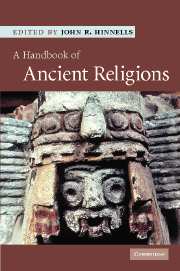Book contents
- Frontmatter
- Contents
- List of illustrations
- List of maps
- List of tables
- List of contributors
- Introduction
- 1 Palaeolithic art and religion
- 2 Ancient Egypt
- 3 Religion in ancient Ugarit
- 4 Mesopotamia
- 5 Ancient Israel to the fall of the Second Temple
- 6 Greek religion
- 7 Religions in the Roman Empire
- 8 Ancient Europe
- 9 The Indus Civilization
- 10 The religion of ancient China
- 11 Aztec and Inca civilizations
- Index
- References
2 - Ancient Egypt
- Frontmatter
- Contents
- List of illustrations
- List of maps
- List of tables
- List of contributors
- Introduction
- 1 Palaeolithic art and religion
- 2 Ancient Egypt
- 3 Religion in ancient Ugarit
- 4 Mesopotamia
- 5 Ancient Israel to the fall of the Second Temple
- 6 Greek religion
- 7 Religions in the Roman Empire
- 8 Ancient Europe
- 9 The Indus Civilization
- 10 The religion of ancient China
- 11 Aztec and Inca civilizations
- Index
- References
Summary
History of scholarship
Ancient Egypt has left the modern world a rich legacy: not only are there well-preserved monuments, artefacts and human remains, but an extensive religious and secular literature has also survived. The following discussion of the religious beliefs and practices will attempt to show how all these sources enable us to understand and interpret ideas and concepts that originated over 5000 years ago (Frankfort 1961; Hornung 1971; Morenz 1973; Shafer 1991). However, it must be stated that even this rich legacy can provide only a partial view of the civilization.
The surviving archaeological evidence is fragmentary, owing on the one hand to environmental and geographical factors and, on the other, to political and cultural practices. Sites in the south of Egypt, better preserved than those in the north because of climatic and environmental variations, have attracted more attention from the excavators. Religious monuments (pyramids, tombs and temples) were largely constructed of stone, so that they would survive ‘for eternity’, whereas cities, towns and domestic buildings, mainly built of mudbrick, have consequently suffered more destruction. This inequality of evidence profoundly affects our knowledge and understanding of the people's daily religious observances.
It was only after Champollion's decipherment of hieroglyphs 200 years ago that scholars were able to translate and begin to understand the texts. Subsequently, intensive study of the language in all its forms has been required to enable scholars to interpret the inscriptions more accurately.
- Type
- Chapter
- Information
- A Handbook of Ancient Religions , pp. 46 - 104Publisher: Cambridge University PressPrint publication year: 2007
References
- 1
- Cited by

